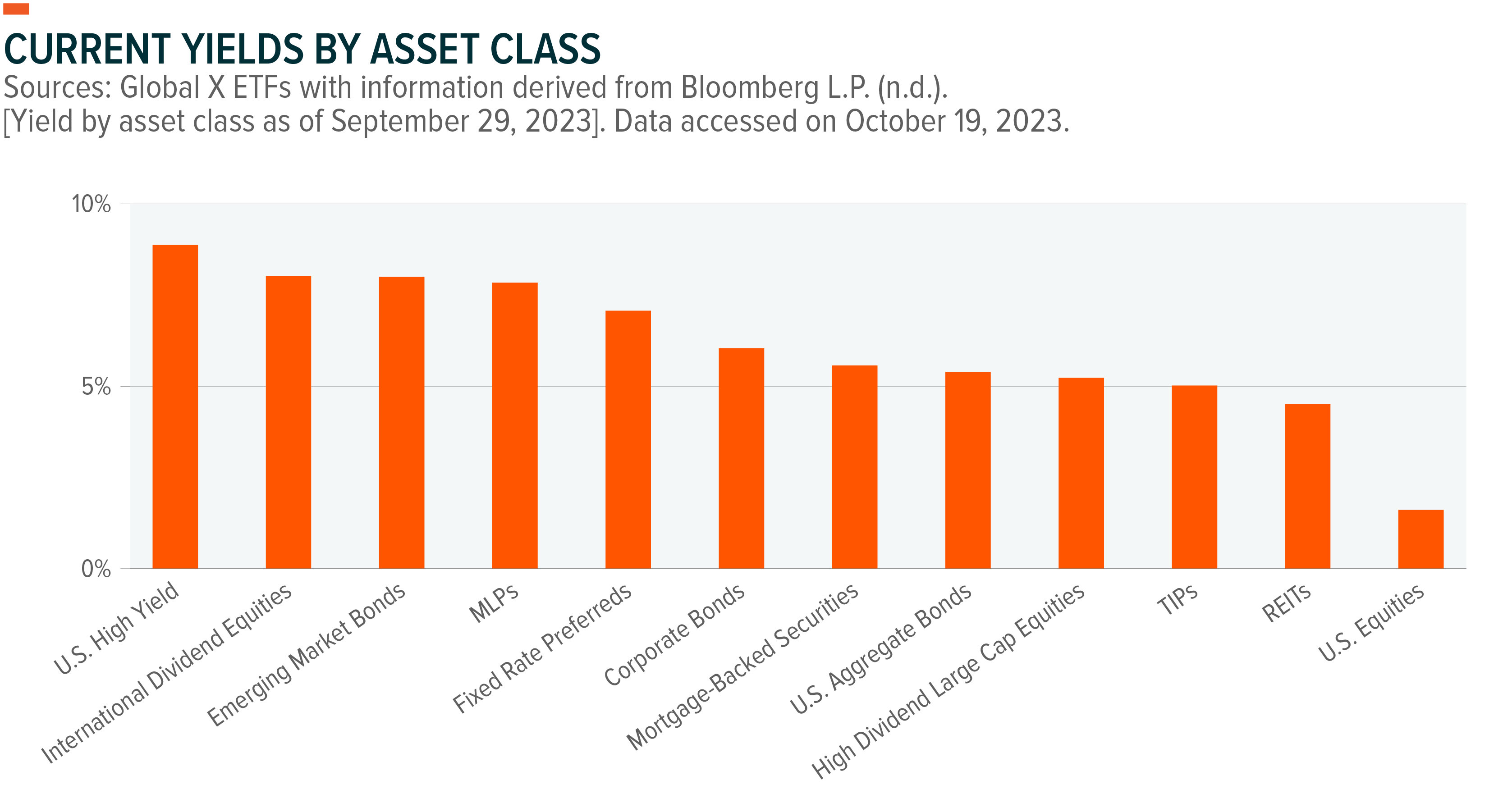On November 8, 2023 we listed the Global X MSCI Emerging Markets Covered Call ETF (EMCC) on the New York Stock Exchange. EMCC is designed to offer investors a source of current income and a differentiated exposure to market volatility, while providing the diversification associated with emerging market economies not found in traditional income-driven accounts.
Portfolio diversification takes on many different forms, but regardless of an investors’ personal goals or proclivities, allocating funds toward a variety of asset classes is traditionally encouraged. Income-driven investors, for instance, have a conventional tendency to pursue risk-averse vehicles like investment grade bonds and large-cap dividend paying equities in an effort to accomplish their goals. However, by incorporating a wider array of potential income streams they have the opportunity to boost the yield on their respective portfolios while simultaneously mitigating a degree of downside risk. The Global X MSCI Emerging Markets Covered Call ETF (EMCC) provides an avenue through which to add to diversification, offering exposure to what is traditionally a relatively volatile underlying asset in an effort to attract higher levels of current income.
Key Takeaways
- The MSCI Emerging Markets Investable Market Index provides a differentiated exposure relative to the major domestic indices. It grants investors the opportunity to diversify risk on an international basis, as well as amongst less developed nations.
- Emerging market economies have a historic tendency to exhibit elevated levels of volatility. This could make them a strong candidate for covered call option writing.
- Investors seeking current income traditionally look to incorporate dividend paying stocks or investment grade bonds into their respective portfolios. Branching out by way of diversification may support higher yields and mitigate portfolio risk.
Gaining Exposure to the MSCI Emerging Markets Investable Market Index
The MSCI Emerging Markets Investable Market Index is a grouping of stocks that spans across 24 different countries, representing some of the fastest-growing economies in the world. The index is market-cap weighted, rebalanced quarterly, and consists of over 3,325 companies. It is differentiated from the MSCI Emerging Markets Index (MXEF) in that it incorporates companies that meet the small-cap market capitalization designation. This leads the index to cover approximately 99% of the free float-adjusted market capitalization in each country, compared to 85% for MXEF.
Historically, growth amongst its constituents has been driven by factors that have allowed the countries in which they reside to narrow the gap between themselves and more developed nations. Some of these factors include expanding populations, internal investments, exports, and adoption of new technologies. The position of these countries in the global economy, pursuing growth from the earlier stages of development, has periodically afforded them the ability to expand at a faster rate. Reliance on specific exports, however, like commodities and other base materials and other factors, have led them to exhibit elevated levels of volatility. Below, we have provided a geographic breakdown of the recent makeup of the index.
Emerging Market Volatility Supports the Case for Option Writing
Income-driven investors often express a conservative demeanor, allocating funds toward instruments that provide a high probability of a specific return. Should they wish to broaden the yield on a broader portfolio, they might find that they’re forced to take on a higher degree of credit risk, or duration risk in the case of a bond. Writing covered calls can offer a means by which to potentially increase current income while simultaneously diversifying risk exposures.
The Global X MSCI Emerging Markets Covered Call ETF (EMCC) purchases shares of the iShares Core MSCI Emerging Markets ETF (IEMG). The fund then proceeds to write FLEX call options, which are options that allow for the customization of key contract terms such as expiration, exercise style, and strike price, that cover 100% of its notional holdings and expire in one month. On the third Friday of every month, the fund distributes the lower of half of its premiums received or 1% of its net asset value (NAV). EMCC will then write new call options with monthly expirations. The distribution cap is an attempt to maintain a constant source of current income. Additionally, the incorporation of FLEX options means that contracts may be designed so they cannot be exercised in the middle of a roll period.

Two core competencies that are associated with the options trade involve the positive relationships that premiums share with moneyness and volatility. This means that, without immediately positioning contracts in the money, writing call options at the money (“ATM”) represents the most advantageous position possible to receive the highest amount of immediate income. It also means that, when writing call options, harnessing a reference asset that exhibits wider levels of volatility will typically provide the seller with stronger premiums.
The Global X MSCI Emerging Markets Covered Call ETF (EMCC) seeks to take advantage of both these relationships. First, it writes its call options at the money. Second, the fund sells contracts against an underlying asset that has a historic propensity to display elevated levels of volatility. Indeed, over the last ten years, the Cboe Emerging Markets Volatility Index has oscillated around the 22.5 level, while Dow Jones Industrial Average, S&P 500, and Nasdaq 100 volatility have tracked in the 17.6, 18.3, and 21.8 vicinities, respectively.1

Looking across the broader landscape of asset classes that income-driven investors might typically employ, the highest of current yields presently resides just north of 8%. Notably, however, Global X covered call funds like QYLD and XYLD are presently yielding 12.84% and 11.91%, respectively.2 By harnessing a similar distribution methodology to these funds and writing call options against assets that may exhibit similar levels of volatility, the Global X MSCI Emerging Markets Covered Call ETF (EMCC) could be able to utilize its premium generating capabilities to create a competitive yield, as well.

Past performance does not guarantee future results.
Asset class representations are as follows: U.S. High Yield, Bloomberg U.S. Corporate High Yield Bond Total Return Index; International Dividend Equities; Dow Jones EPAC Select Dividend TR Index; MLPs, S&P MLP Index; Emerging Market Bonds, Bloomberg EM USD Aggregate Total Return Index; Fixed Rate Preferreds, ICE BofA Fixed Rate Preferred Securities Index; Corporate Bonds, Bloomberg U.S. Corporate Bond Total Return Index; Mortgage-Backed Securities, Bloomberg U.S. Mortgage Backed Securities Index; U.S. Aggregate Bonds, Bloomberg U.S. Aggregate Bond Index; High Dividend Large Cap Equities, S&P 500 High Dividend Index; TIPs, Bloomberg U.S. Treasury U.S. TIPS TR USD Index; REITs, FTSE NAREIT All Equity REITs Total Return Index; U.S. Equities, S&P 500 Index.
The MSCI Emerging Markets IMI Provides a Form of Diversification
It’s easy to group assets into broadly labelled buckets that support a “risk-on” or “risk-off” mentality. Based on the volatility metrics that we’ve highlighted a conservative investor could certainly proceed to characterize the MSCI Emerging Markets IMI in this binary fashion and move on to seek out instruments of a more conservative nature. That said, when constructing a diversified portfolio, it is important to note the different types of risk that are being taken on by adding positions and understand where heavy exposure to these risks might lie. Allocating capital toward assets that correlate differently with similar types of risk can serve to reduce the beta coefficient associated with a roster of investments. Additionally, it can allow investors to pursue instruments that might fall into the “risk-on” bucket that may have been formerly overlooked. Below we have provided a comparison of the sector weights associated with the MSCI Emerging Markets IMI relative to the S&P 500 High Dividend index, which investors may seek to replicate in an effort to obtain dividend income.

Beyond specific sector exposures, traditional income investors tend to gravitate toward particular asset classes such as investment grade bonds, government bonds, or large-cap dividend paying stocks. Consequently, they might find that their portfolios contain material exposure to credit, inflationary, or company-specific risk. However, by incorporating a covered call strategy into a basket of investments they can potentially acquire a source of current yield while mitigating some of these risks.
Pursuing a covered call strategy using emerging market investments can expand investors’ risk profiles across various currencies, political scapes, and other country-specific factors. At first blush, it might seem like somewhat of a fruitless endeavor, seeking to incorporate what are typically more risky assets to reduce variability within a portfolio. However, trading out the interest rate risk or inflation risk associated with one specific economy for another may be a good way to add a supplemental level of diversification.
Conclusion
The global economy has been under significant pressure over the last few years. However, with interest rates still high and corporate earnings recently challenged, an economic recovery stateside may be prone to some drawbacks and corrections. This being the case, investors might find that diversifying assets into the emerging markets represents an attractive opportunity. The Global X MSCI Emerging Markets Covered Call ETF (EMCC) offers investors the potential to generate a competitive yield while diversifying internationally. The strategy can represent a potential portfolio hedge, providing the investor with exposure to a positive relationship with volatility within emerging markets. It can also create a degree of downside protection for an investor’s emerging market exposure, harnessing the premiums that it earns to potentially outperform the MSCI Emerging Markets IMI when the market is facing adversity.
Related ETFs
EMCC – Global X MSCI Emerging Markets Covered Call ETF
QYLD – Global X Nasdaq 100 Covered Call ETF
XYLD – Global X S&P 500 Covered Call ETF
RYLD – Global X Russell 2000 Covered Call ETF
DJIA – Global X Dow Jones Industrial Average Covered Call ETF
EMM – Global X Emerging Markets ex-China ETF
EMC – Global X Emerging Markets Great Consumer ETF
Click the fund name above to view current holdings. Holdings are subject to change. Current and future holdings are subject to risk.
 Robert J. Scrudato
Robert J. Scrudato